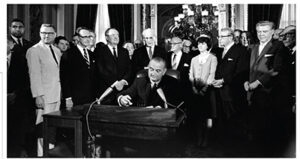
 Should Blacks continue down the path of non-violence?
Should Blacks continue down the path of non-violence?
By Larry S. Buford
Meekness is not weakness. Consider the bridled horse: Although strong and mighty, it is controlled by the bit placed in its mouth. That’s power under control. Now if a horse gets spooked by a rattlesnake or a loud sudden noise, it will by nature ignore the restriction of the bit, rear up, and perhaps throw its rider in response as a defense mechanism to mitigate the threat of safety. Everyone wants to feel safe, right?
In the same way, Dr. Martin Luther King, Jr., who became a powerhouse in the civil rights movement, trumpeted non-violence with the “bit” of the gospel in his mouth. Like the horse, as a minister, he was restrained by that bit. Now, do you think he was not alarmed and frightened by cross-burnings (the rattle of human “snakes”) or the loud noises of gunfire and bombs? Well of course he was! It’s human nature. I once heard of an account where Dr. King was in a situation where he lowered his head to pray but kept one eye open.
In 1944, as a junior in high school, Dr. King competed in a debate contest and delivered a speech titled The Negro and the Constitution – a topic on whether American Blacks were being treated according to American values laid out by the Founding Fathers. Dr. King said the Civil War and the Reconstruction era produced a “new order” with the ratification of the fourteenth and other amendments to the Constitution; amendments that ensured the promise of equality that went beyond the original Declaration of Independence. By the way: The Fourteenth Amendment was ratified in 1868; 100 years before Dr. King was assassinated.
With former president Trump’s base threatening civil war if he is 1. Not allowed on the ballot; 2. Sent to prison; or 3. Defeated in the presidential election – many Blacks and other non-Whites are wondering whether or not to take up arms as so many Whites have already done. Judging from all the disinformation that republicans continue promulgating to stir their base, and how Trump continues to throw fuel on the fire, this has become a matter of great consternation, and must be taken seriously.
I once heard a man say, “for me to be killed for what I believe is one thing, but it is my duty to defend and protect my family.” Domestic terrorist groups justify their arsenals for protection against the government. The question we’re all facing in times like these is “what time is it?” The Bible says in Ecclesiastes 3:7-8 (AMP) “A time to tear apart and a time to sew together; a time to keep silent and a time to speak. A time to love and a time to hate; a time for war and a time for peace.”
In public Dr. King stressed non-violence, but here’s an account of an incident that reportedly took place in 1956 after his home was bombed and he was denied a permit to carry a gun: “In 1956, after journalist William Worthy nearly sat on a loaded gun in an armchair in Martin Luther King Jr.’s house during the Montgomery Bus Boycott, he could hardly know that his report on the incident would become a mere footnote in King’s journey to nonviolence.” [by Dara T. Mathis, The Atlantic]. So, after being denied a permit, Dr. King somehow came into possession of a gun anyway. Why? Was violence riding shotgun with Dr. King’s non-violence ideology? Perhaps no. I think he just wanted to defend and protect his family.
**************************************
 An Unintended Legacy of the Voting Rights Act of 1965
An Unintended Legacy of the Voting Rights Act of 1965
On August 6, 1965, President Lyndon Johnson came to the Capitol to sign the Voting Rights Act. Following a ceremony in the Rotunda, the president, congressional leaders, Martin Luther King, Jr., Rosa Parks, and others crowded into the President’s Room near the Senate Chamber for the actual signing.
President Johnson noticed that the enrolled copy of the act rested on a familiar-looking writing desk. That desk had been handmade in the 1860s for use in the Supreme Court during its residence in the Capitol. When the Court finally got a building of its own in 1935, some of its furniture remained behind.
In the mid-1950s, the forsaken desk had attracted the acquisitive eye of then-Majority Leader Lyndon Johnson, relentlessly on the lookout for historic furnishings to embellish his Capitol office. So, in 1965, when President Johnson spied that familiar object at the signing ceremony, he told Majority Leader Mike Mansfield that he wished to have it to sent to Austin, Texas, where his presidential library would be located.
A keen student of history and defender of Senate institutional prerogatives, Mansfield instinctively bridled at Johnson’s request, but, who wants to say “no” to the president? Any response along the lines of, “But, Mr. President, this desk has been in the Capitol’s Senate wing for more than a century,” would likely have been met with an uncomprehending stare. So, Mansfield reluctantly allowed it to be moved to Texas.
Decades later, in 2005, Senate officials asked that the desk be returned to the Capitol for eventual display in the Capitol Visitor Center. Johnson Library officials sent their regrets with an explanation that it was on “permanent” exhibition. That same Johnson Library collection had also come to include mahogany Senate office desks, constructed a century ago for senators’ use in the Russell Building—not one, not two, but three of them!
Following the 1965 episode, Leader Mansfield determined that such a loss of Senate antiquities must not be repeated. After several unsuccessful attempts to interest House leaders in a Congress-wide preservation program, Mansfield, along with Republican Leader Everett Dirksen, arranged in 1968 for the creation of the Senate Commission on Art. That panel, composed of the Senate’s floor leaders, president pro tempore, and the chair and ranking member of the Rules and Administration Committee, would have the muscle to ward off any further diminishing of the Senate’s cultural heritage. Today, the commission’s accomplishments range from the restoration of the Old Senate and Supreme Court chambers in the mid-1970s to the acquisition of a giant portrait of Henry Clay
President Johnson described the 1965 Voting Rights Act as “a triumph for freedom as huge as any victory won on any battlefield.” An unintended legacy of that epochal day lies in the Senate’s ongoing programs to preserve and document its past for the benefit of current and future generations.
**********************************************
 Advancing Dr. King’s voting rights legacy
Advancing Dr. King’s voting rights legacy
Submitted by TheGrio
“So long as I do not firmly and irrevocably possess the right to vote I do not possess myself,” Dr. Martin Luther King Jr. once said. “I cannot make up my mind – it is made up for me. I cannot live as a democratic citizen, observing the laws I have helped to enact – I can only submit to the edict of others.”
In 1965, thanks in large measure to Dr. King’s moral leadership, the Voting Rights Act was signed into law by President Lyndon Johnson, finally giving millions of African Americans the most fundamental right in a self-governing society – the right to choose our elected representatives, instead of submitting “to the edict of others.”
But now, in 2022, as we prepare to honor Dr. King on his birthday, voting rights are under siege.
Last year alone, 19 states passed 34 laws restricting access to the ballot box and silencing the voices in particular of communities of color, voters voters with disabilities, young people and other historically underrepresented groups. The powerful forces behind these laws have made a ruthless calculation. They know that they can’t win on the merits, that their agenda doesn’t have enough public support to win fair and square, so they are rigging the system instead.


Be the first to comment